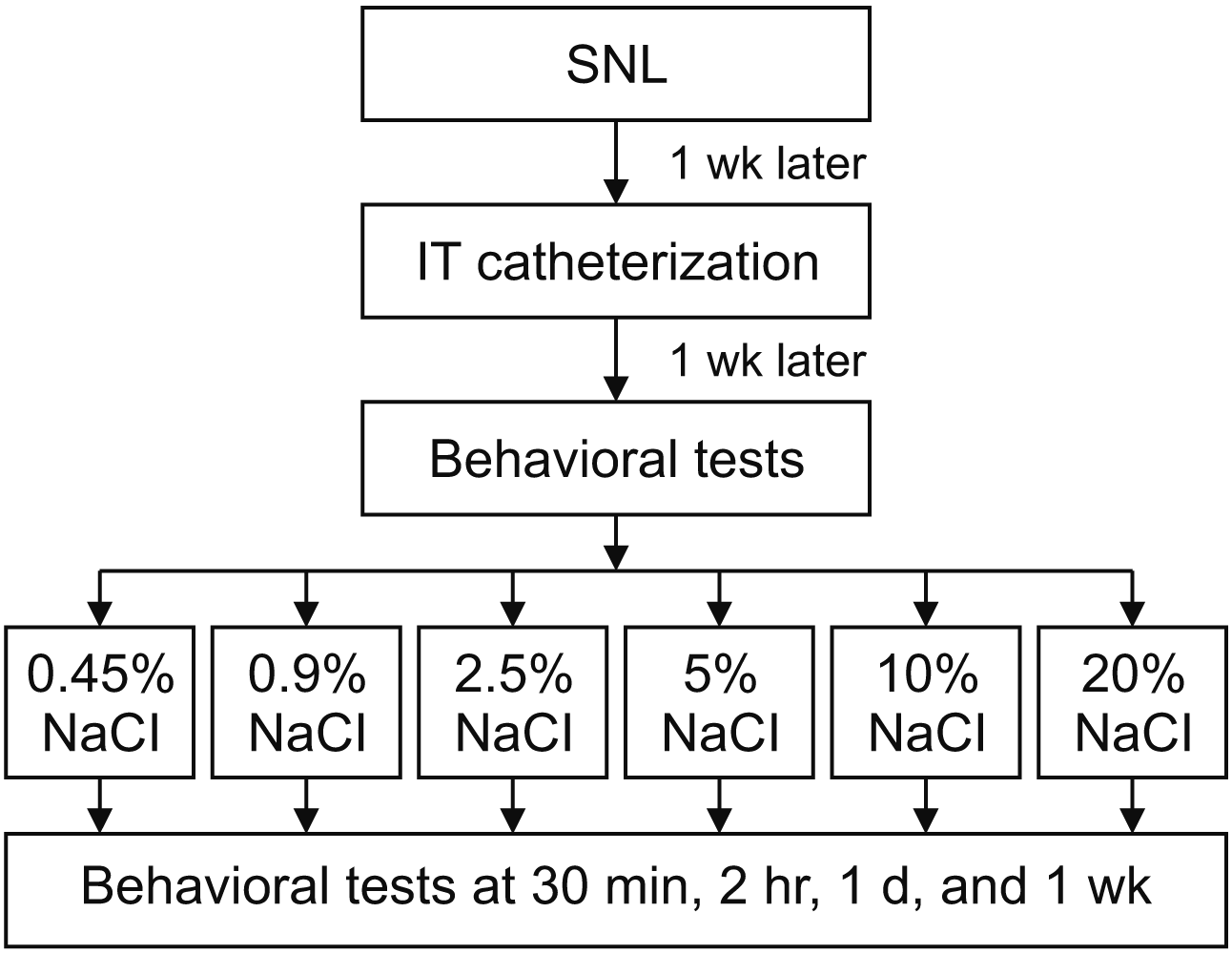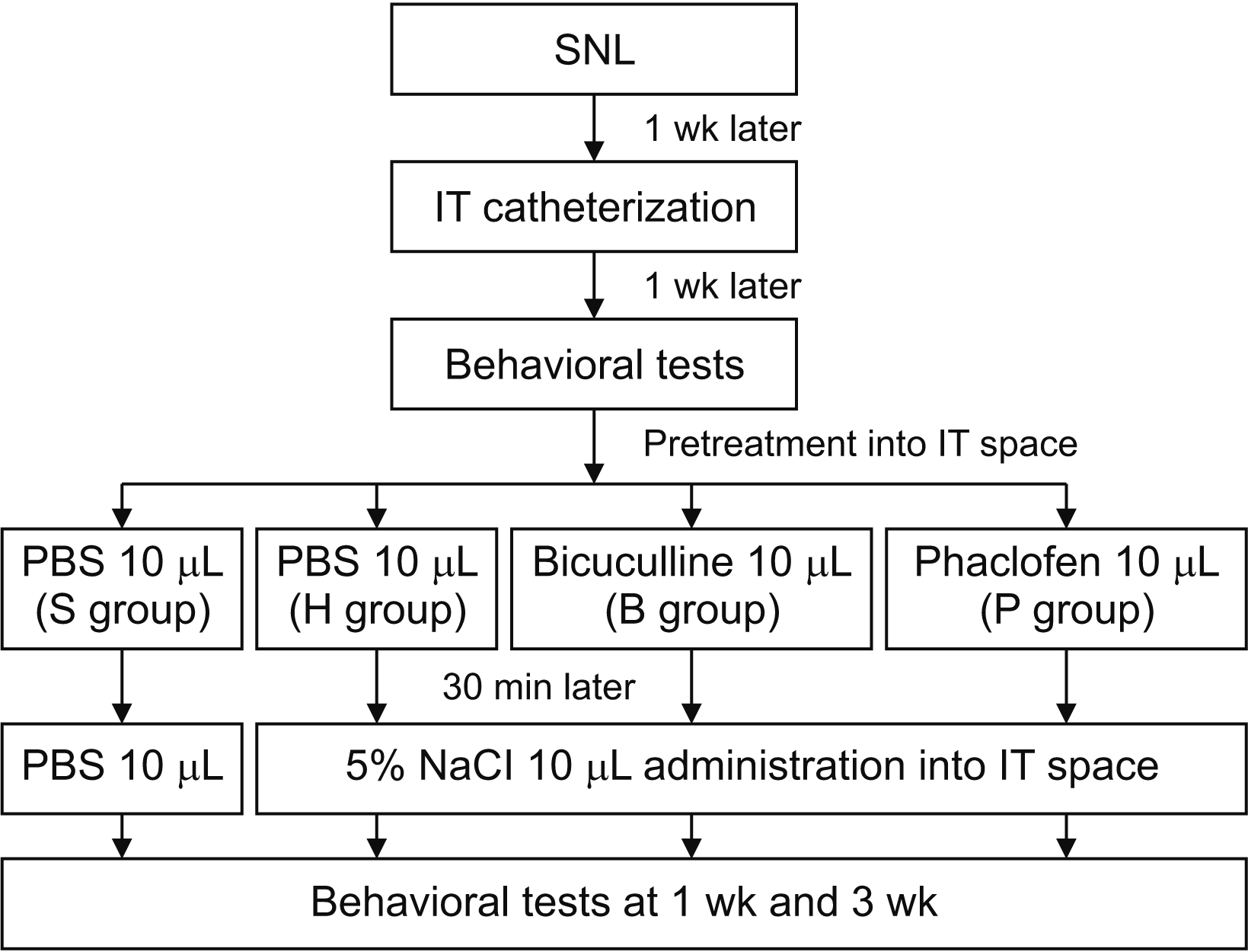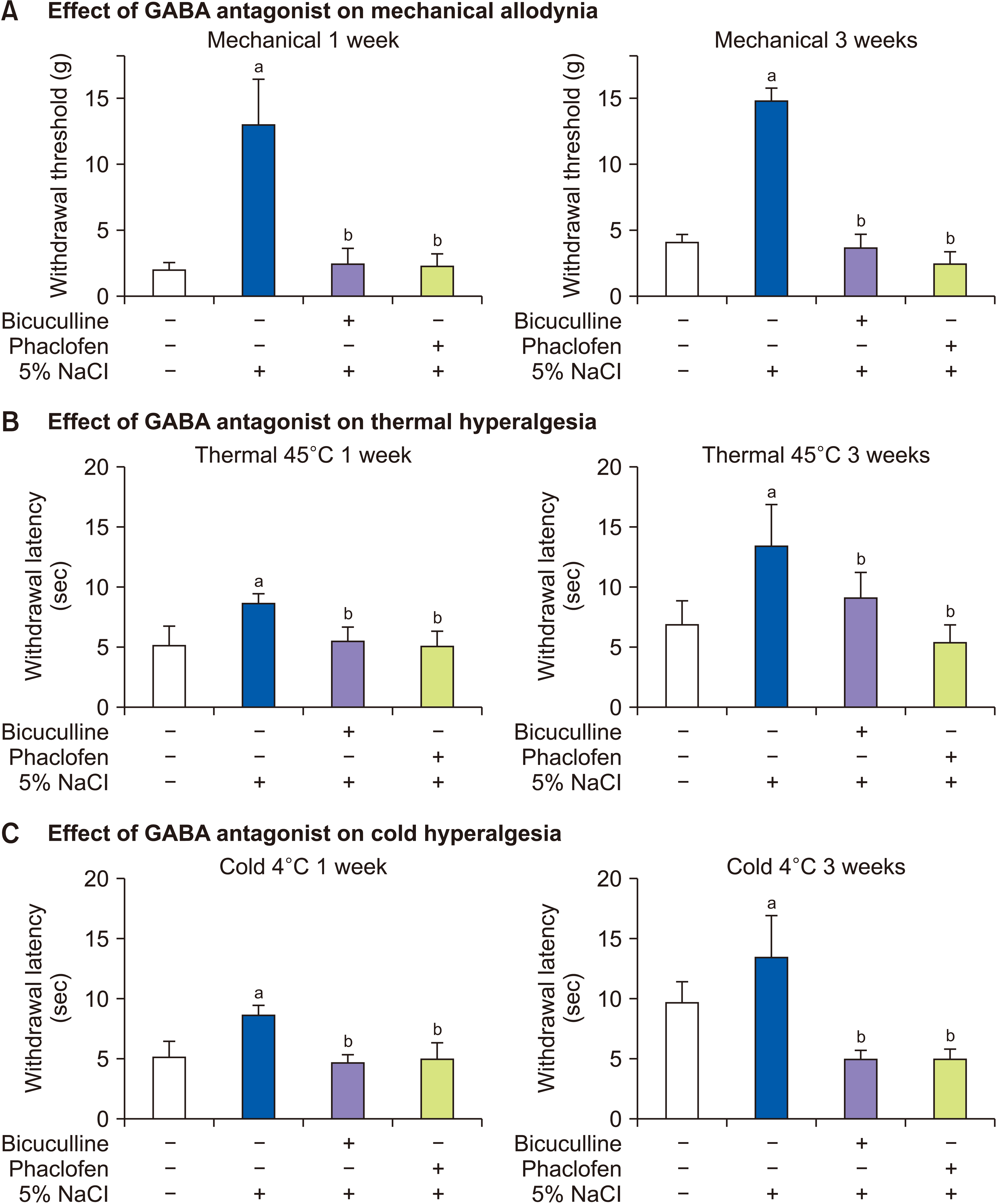3. Lucas JT, Ducker TB, Perot PL Jr. 1975; Adverse reactions to intrathecal saline injection for control of pain. J Neurosurg. 42:557–61. DOI:
10.3171/jns.1975.42.5.0557. PMID:
1173818.

5. Racz GB, Heavner JE, Singleton W, Carline M. Racz GB, editor. 1989. Hypertonic saline and corticosteroid injected epidurally for pain control. Techniques of neurolysis. Springer US;p. 73–86. DOI:
10.1007/978-1-4899-6721-3_7.
6. Joo EY, Koh WU, Choi SS, Choi JH, Ahn HS, Yun HJ, et al. 2017; Efficacy of adjuvant 10% hypertonic saline in transforaminal epidural steroid injection: a retrospective analysis. Pain Physician. 20:E107–14. DOI:
10.36076/ppj.2017.1.E107. PMID:
28072802.
7. Koh WU, Choi SS, Park SY, Joo EY, Kim SH, Lee JD, et al. 2013; Transforaminal hypertonic saline for the treatment of lumbar lateral canal stenosis: a double-blinded, randomized, active-control trial. Pain Physician. 16:197–211. DOI:
10.36076/ppj.2013/16/197. PMID:
23703407.
8. Lee Y, Kim S, Shin JW, Leem JG, Choi SS. 2021; Adjuvant administration of hypertonic saline in lumbar epidural intervention may be associated with successful response in patients with probable neuropathic radicular pain Screened by Douleur Neuropathique 4. Int J Med Sci. 18:2736–42. DOI:
10.7150/ijms.59695. PMID:
34104106. PMCID:
PMC8176191.

9. Karm MH, Kim CS, Kim DH, Lee D, Kim Y, Shin JW, et al. 2023; Effectiveness of percutaneous epidural neuroplasty using a balloon catheter in patients with chronic spinal stenosis accompanying mild spondylolisthesis: a longitudinal cohort study. Korean J Pain. 36:184–94. DOI:
10.3344/kjp.22289. PMID:
36514933. PMCID:
PMC10043794.

10. Heavner JE, Racz GB, Raj P. 1999; Percutaneous epidural neuroplasty: prospective evaluation of 0.9% NaCl versus 10% NaCl with or without hyaluronidase. Reg Anesth Pain Med. 24:202–7. DOI:
10.1016/S1098-7339(99)90128-1. PMID:
10338168.
11. Manchikanti L, Rivera JJ, Pampati V, Damron KS, McManus CD, Brandon DE, et al. 2004; One day lumbar epidural adhesiolysis and hypertonic saline neurolysis in treatment of chronic low back pain: a randomized, double-blind trial. Pain Physician. 7:177–86. DOI:
10.36076/ppj.2004/7/177. PMID:
16868590.
12. Choi EJ, Yoo YJ, Lee PB, Kim YC, Lee SC, Moon JY. 2017; A retrospective study to evaluate the effect of concentration of hypertonic saline on efficacy and safety of epidural adhesiolysis. Anesth Analg. 124:2021–9. DOI:
10.1213/ANE.0000000000001925. PMID:
28448392.

14. Watanabe M, Maemura K, Kanbara K, Tamayama T, Hayasaki H. 2002; GABA and GABA receptors in the central nervous system and other organs. Int Rev Cytol. 213:1–47. DOI:
10.1016/S0074-7696(02)13011-7. PMID:
11837891.

15. Jensen ML, Timmermann DB, Johansen TH, Schousboe A, Varming T, Ahring PK. 2002; The beta subunit determines the ion selectivity of the GABAA receptor. J Biol Chem. 277:41438–47. DOI:
10.1074/jbc.M205645200. PMID:
12177063.
16. Sieghart W, Sperk G. 2002; Subunit composition, distribution and function of GABA(A) receptor subtypes. Curr Top Med Chem. 2:795–816. DOI:
10.2174/1568026023393507. PMID:
12171572.

18. Kim SH, Nam JS, Choi DK, Koh WW, Suh JH, Song JG, et al. 2011; Tumor necrosis factor-alpha and apoptosis following spinal nerve ligation injury in rats. Korean J Pain. 24:185–90. DOI:
10.3344/kjp.2011.24.4.185. PMID:
22220239. PMCID:
PMC3248581.

19. Kim SH, Chung JM. 1992; An experimental model for peripheral neuropathy produced by segmental spinal nerve ligation in the rat. Pain. 50:355–63. DOI:
10.1016/0304-3959(92)90041-9. PMID:
1333581.

21. Chaplan SR, Bach FW, Pogrel JW, Chung JM, Yaksh TL. 1994; Quantitative assessment of tactile allodynia in the rat paw. J Neurosci Methods. 53:55–63. DOI:
10.1016/0165-0270(94)90144-9. PMID:
7990513.

22. Li Y, Dorsi MJ, Meyer RA, Belzberg AJ. 2000; Mechanical hyperalgesia after an L5 spinal nerve lesion in the rat is not dependent on input from injured nerve fibers. Pain. 85:493–502. DOI:
10.1016/S0304-3959(00)00250-5. PMID:
10781924.

24. Biella GE, Groppetti A, Novelli A, Fernández-Sánchez MT, Manfredi B, Sotgiu ML. 2003; Neuronal sensitization and its behavioral correlates in a rat model of neuropathy are prevented by a cyclic analog of orphenadrine. J Neurotrauma. 20:593–601. DOI:
10.1089/089771503767168519. PMID:
12906743.

25. Malan TP, Mata HP, Porreca F. 2002; Spinal GABA(A) and GABA(B) receptor pharmacology in a rat model of neuropathic pain. Anesthesiology. 96:1161–7. DOI:
10.1097/00000542-200205000-00020. PMID:
11981157.
26. Hara K, Haranishi Y, Kataoka K, Takahashi Y, Terada T, Nakamura M, et al. 2014; Chlorogenic acid administered intrathecally alleviates mechanical and cold hyperalgesia in a rat neuropathic pain model. Eur J Pharmacol. 723:459–64. DOI:
10.1016/j.ejphar.2013.10.046. PMID:
24184666.

28. King JS, Jewett DL, Sundberg HR. 1972; Differential blockade of cat dorsal root C fibers by various chloride solutions. J Neurosurg. 36:569–83. DOI:
10.3171/jns.1972.36.5.0569. PMID:
5067506.

29. Anderson SR, Racz GB, Heavner J. 2000; Evolution of epidural lysis of adhesions. Pain Physician. 3:262–70. DOI:
10.36076/ppj.2000/3/262. PMID:
16906184.

30. Gerdesmeyer L, Wagenpfeil S, Birkenmaier C, Veihelmann A, Hauschild M, Wagner K, et al. 2013; Percutaneous epidural lysis of adhesions in chronic lumbar radicular pain: a randomized, double-blind, placebo-controlled trial. Pain Physician. 16:185–96. DOI:
10.36076/ppj.2013/16/185. PMID:
23703406.
31. Jewett DL, King JS. 1971; Conduction block of monkey dorsal rootlets by water and hypertonic saline solutions. Exp Neurol. 33:225–37. DOI:
10.1016/0014-4886(71)90116-6. PMID:
5000936.

33. Zeilhofer HU, Benke D, Yevenes GE. 2012; Chronic pain states: pharmacological strategies to restore diminished inhibitory spinal pain control. Annu Rev Pharmacol Toxicol. 52:111–33. DOI:
10.1146/annurev-pharmtox-010611-134636. PMID:
21854227.

34. Hwang JH, Yaksh TL. 1997; The effect of spinal GABA receptor agonists on tactile allodynia in a surgically-induced neuropathic pain model in the rat. Pain. 70:15–22. DOI:
10.1016/S0304-3959(96)03249-6. PMID:
9106805.

35. Sokal DM, Chapman V. 2003; Effects of spinal administration of muscimol on C- and A-fibre evoked neuronal responses of spinal dorsal horn neurones in control and nerve injured rats. Brain Res. 962:213–20. DOI:
10.1016/S0006-8993(02)04057-X. PMID:
12543472.

36. Loomis CW, Khandwala H, Osmond G, Hefferan MP. 2001; Coadministration of intrathecal strychnine and bicuculline effects synergistic allodynia in the rat: an isobolographic analysis. J Pharmacol Exp Ther. 296:756–61. PMID:
11181903.
37. Anseloni VC, Gold MS. 2008; Inflammation-induced shift in the valence of spinal GABA-A receptor-mediated modulation of nociception in the adult rat. J Pain. 9:732–8. DOI:
10.1016/j.jpain.2008.03.004. PMID:
18467182. PMCID:
PMC2581496.

38. Sivilotti L, Woolf CJ. 1994; The contribution of GABAA and glycine receptors to central sensitization: disinhibition and touch-evoked allodynia in the spinal cord. J Neurophysiol. 72:169–79. DOI:
10.1152/jn.1994.72.1.169. PMID:
7965003.

39. Caba M, González-Mariscal G, Beyer C. 1994; Perispinal progestins enhance the antinociceptive effects of muscimol in the rat. Pharmacol Biochem Behav. 47:177–82. DOI:
10.1016/0091-3057(94)90128-7. PMID:
8115419.

40. Dirig DM, Yaksh TL. 1995; Intrathecal baclofen and muscimol, but not midazolam, are antinociceptive using the rat-formalin model. J Pharmacol Exp Ther. 275:219–27.








 PDF
PDF Citation
Citation Print
Print



 XML Download
XML Download